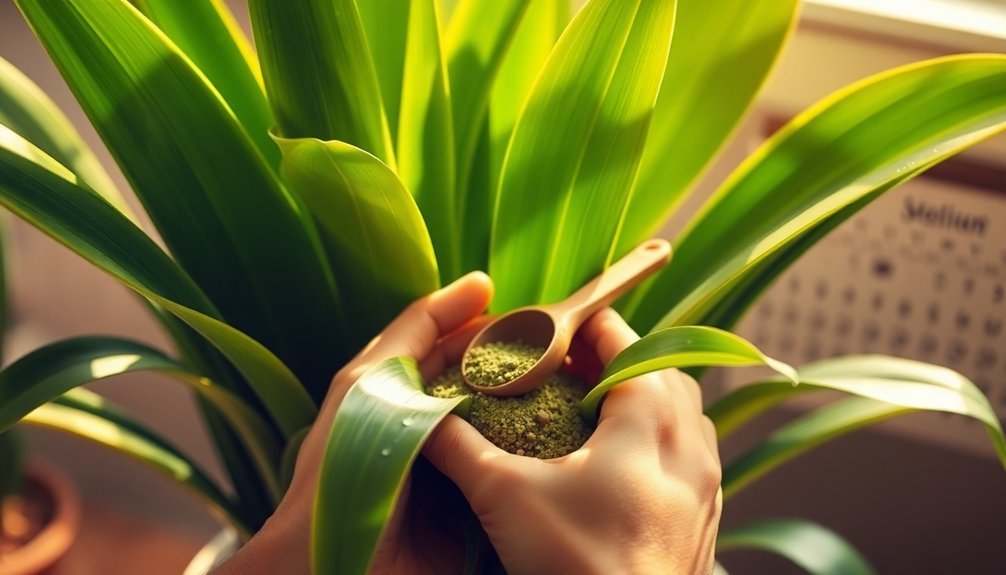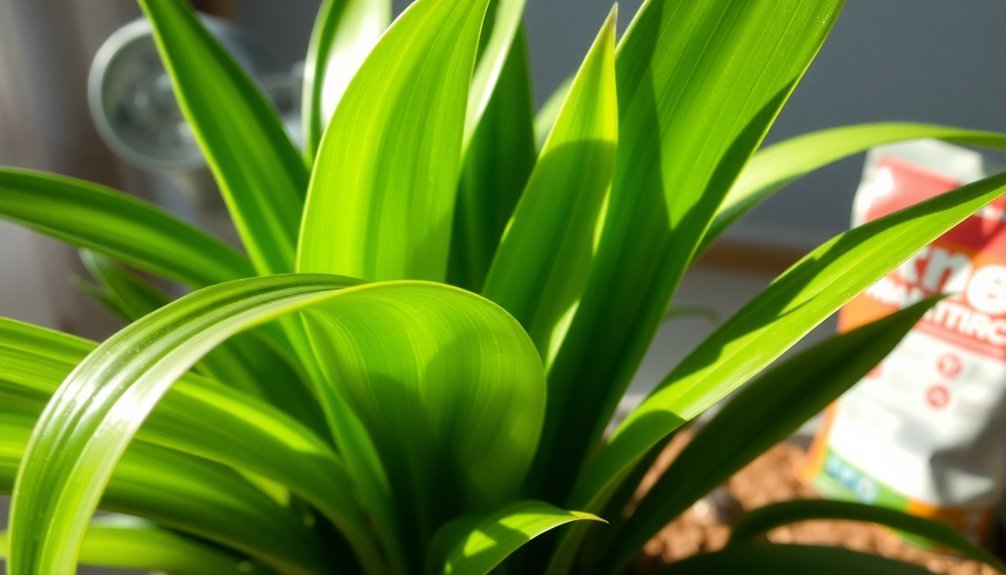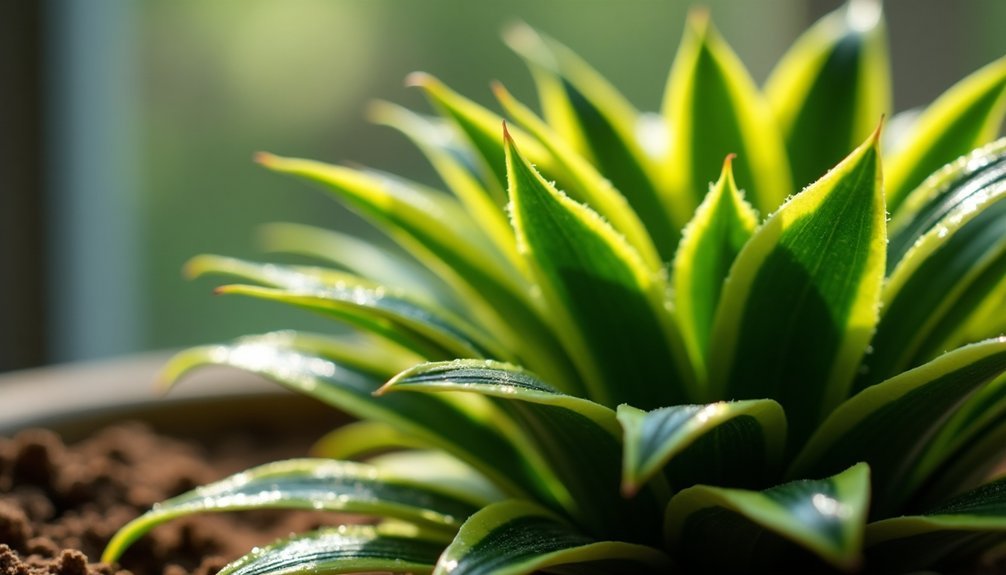Feed your dracaena plant monthly during the growing season from March through September using a balanced, water-soluble fertilizer. You'll want to start with a light feeding in early spring, increase frequency during summer months if the plant gets bright light, and reduce feeding in autumn. Skip fertilizing in winter when the plant is dormant. Watch for signs like pale leaves or brown tips to adjust your feeding schedule. Understanding your plant's specific needs will help you create the perfect nutrient balance.
Understanding the Best Seasons for Dracaena Fertilization

While Dracaena plants are relatively low-maintenance, they require specific seasonal fertilization to thrive throughout the year.
You'll want to begin fertilizing in early spring when your plant shows new growth, using a balanced, low-dose plant food on damp soil. Remember that less is more when applying fertilizer to prevent damaging your plant.
During summer, if your Dracaena receives bright light or lives outdoors, feed it monthly with fertilizer diluted to half strength.
You'll need to maintain consistent watering to support nutrient absorption but avoid feeding during extreme heat.
As autumn approaches, reduce fertilization frequency to help your plant shift toward dormancy.
Stop feeding completely by late autumn.
In winter, your Dracaena doesn't need fertilizer as it enters its rest period.
Just focus on maintaining proper humidity, temperature, and watering until spring returns.
Choosing the Right Fertilizer Type for Your Dracaena
Now that you understand when to feed your Dracaena, selecting the right type of fertilizer will make a major difference in your plant's health.
If soil lacks proper drainage holes, you must be extra cautious as excess fertilizer buildup can severely damage roots.
You'll find several options available, each with distinct advantages.
Liquid fertilizers with a balanced NPK ratio of 10-10-10 or 20-20-20 offer quick nutrient absorption but require application every 4-6 weeks.
While they're easy to use, be careful not to over-apply, as this can cause leaf burn.
If you're busy, consider granular or slow-release fertilizers, which need less frequent application.
Slow-release options like Osmocote can feed your plant for up to 6 months.
For eco-conscious gardeners, organic fertilizers provide gentle, sustained nutrition, though they work more slowly than synthetic options.
Whatever you choose, proper application is key to preventing root damage and ensuring even nutrient distribution.
Recognizing Signs Your Dracaena Needs Feeding

Understanding when your Dracaena needs fertilizer can prevent potential growth issues before they become severe. Watch for key signs like pale green foliage, stunted growth, and long, narrow leaves with wavy margins, which indicate nitrogen deficiency. If you notice a rosettelike arrangement of younger leaves or rustlike pustules on mature leaves, your plant likely needs phosphorus. Young leaves showing severe chlorosis and necrosis often indicate an iron deficiency that requires immediate attention. You'll also want to monitor for wilted leaves and reddish-blue coloring, signaling potassium deficiency. If left untreated, these deficiencies can impact your plant's blooming and overall health, so it's essential to address feeding needs promptly.
| Sign | Nutrient Need |
|---|---|
| Pale green leaves, wavy margins | Nitrogen |
| Rosettelike new growth, deep green | Phosphorus |
| Wilted leaves, bluish-red color | Potassium |
| Severe marginal serration | Calcium |
Monthly Feeding Schedule During Growing Season
During the growing season, your Dracaena needs regular fertilization to maintain its vibrant foliage and healthy growth. Feed your plant once a month from March through September using a balanced, water-soluble fertilizer.
If you're growing outdoors or in sunny spots, increase feeding to every two months. For indoor plants using houseplant fertilizer, you can feed every two weeks.
Key feeding guidelines to follow:
- Use a low-dose balanced fertilizer (1-1-1 NPK ratio) or dilute stronger solutions to prevent root burn.
- Apply fertilizer evenly to the soil and water thoroughly afterward.
- Skip fertilizing in the first year if your potting mix contains slow-release nutrients.
- Reduce or stop feeding during fall and winter when your plant enters dormancy.
Remember to adjust your feeding schedule based on your plant's environment and light exposure for best results.
Balancing Water and Nutrient Requirements

The delicate balance between water and nutrients plays a crucial role in your Dracaena's health and growth. To maintain this balance, you'll need to monitor soil moisture and use the right type of water when feeding your plant.
| Watering Aspect | Key Requirement |
|---|---|
| Water Type | Distilled, purified, or rainwater |
| Soil Check | Insert finger to knuckle depth |
| Moisture Level | Allow top 1-2 inches to dry |
| Warning Signs | Yellow/brown tips indicate imbalance |
Before applying nutrients, confirm the soil is slightly moist but not waterlogged. You'll want to use room temperature water to avoid shocking the roots, and always water thoroughly until it drains from the bottom. If you're seeing yellow spots or brown tips on leaves, check both your water quality and nutrient levels, as these can indicate an imbalance in either.
Frequently Asked Questions
Can I Use Coffee Grounds as a Natural Fertilizer for My Dracaena?
Yes, you can use coffee grounds as a natural fertilizer for your dracaena. They'll provide essential nutrients, improve soil structure, and offer slow-release benefits. Mix them with water or sprinkle dried grounds sparingly around the base.
Should I Fertilize My Dracaena Immediately After Repotting?
Don't fertilize your dracaena right after repotting. You'll need to wait a few weeks while it adjusts to its new home. The fresh potting soil already contains enough nutrients for now.
Do Variegated Dracaena Varieties Need Different Fertilization Than Solid-Colored Ones?
No, you don't need to fertilize variegated and solid-colored Dracaena varieties differently. They both require the same balanced fertilizer with a 10-10-10 NPK ratio, applied monthly during the growing season.
Will Fertilizing Help Restore a Dracaena Damaged by Cold Exposure?
No, you shouldn't fertilize a cold-damaged dracaena immediately. It'll only stress the plant further. Wait until you see signs of recovery, like new growth, before adding any fertilizer. Focus on proper watering first.
Can I Mix Different Types of Fertilizers for My Dracaena?
You shouldn't mix different fertilizers for your dracaena. It can create nutrient imbalances and cause chemical reactions that harm your plant. Instead, stick to one balanced, all-purpose houseplant fertilizer for best results.
In Summary
Maintaining a healthy dracaena isn't complicated when you've got the right feeding schedule. Remember to fertilize during spring and summer months, use a balanced liquid fertilizer, and watch for yellowing leaves that signal feeding time. Don't overdo it – feed monthly during growing season and skip fertilizing in winter. If you're following these essential tips, you'll enjoy a thriving, vibrant dracaena for years to come.
References
- https://www.gardeningknowhow.com/houseplants/dracaena/how-to-fertilize-dracaena-plants.htm
- https://www.plantsforallseasons.co.uk/blogs/dracaena-care/how-to-water-a-dracaena
- https://jomostudio.com/blogs/plant-with-jomo/how-to-take-care-of-your-dracaena
- https://plantaddicts.com/fertilizing-dracaena/
- https://www.youtube.com/watch?v=_TqGzcP1pBo
- https://www.youtube.com/watch?v=yXCtvwsap6Q
- https://gardenerspath.com/plants/houseplants/fertilize-dracaena/
- https://bloomscape.com/plant-care-guide/dracaena/
- https://tenneyplants.com/how-to-fertilize-dracaena/
- https://cafeplanta.com/blogs/resources/best-fertilizer-for-dracaena
- https://www.thespruce.com/dracaena-overview-care-1902754
- https://revistas.upr.edu/index.php/jaupr/article/view/10409
- https://bloomscape.com/common-issue/why-are-the-leaves-on-my-dracaena-turning-yellow/
- https://www.beegreen365.com/services/shrub-and-ornamental-care/dracaena-plant-care/
- https://eureka-farms.com/pages/the-must-read-guide-for-growing-dracaena-plants
- https://cafeplanta.com/a/blog/the-ultimate-compact-dracaena-care-guide
- https://gardenerspath.com/plants/houseplants/water-dracaena/
- https://houseplantresourcecenter.com/2023/02/essential-tips-for-watering-dracaena-marginata/
- https://www.homesandgardens.com/gardens/coffee-ground-fertilizer-for-houseplants
- https://home.howstuffworks.com/green-living/use-diluted-coffee-to-fertilize-plants.htm





Leave a Reply